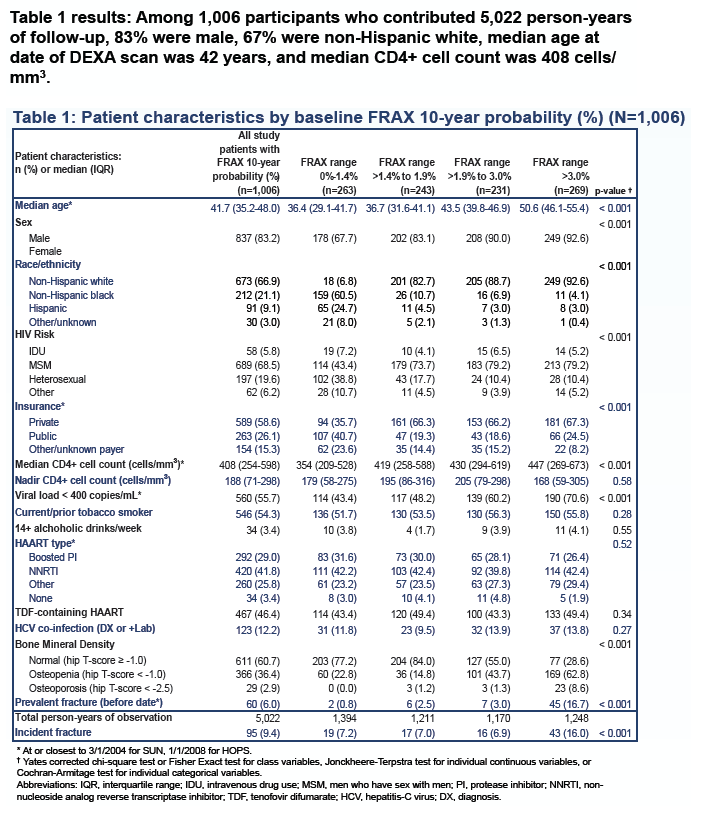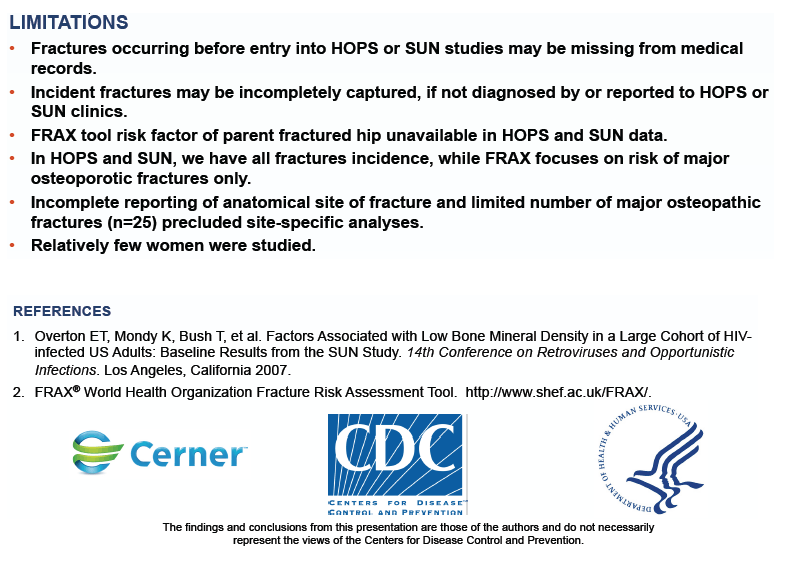 |
 |
 |
| |
New Fracture Risk and FRAX 10-Year Probability
of Fracture in HIV-infected Adults
|
| |
| |
Reported by Jules Levin
CROI 2014 March 3-6 Boston, MA
L Battalora1, K Buchacz2, C Armon3, ET Overton4, J Hammer5, P Patel2, JS Chmiel6, K Wood3, JT Brooks2, B Young7,8 and the HIV Outpatient Study and SUN Study Investigators
1Colorado School of Mines, Golden, CO; 2Centers for Disease Control and Prevention, Atlanta, GA; 3Cerner Corporation, Vienna, VA; 4University of Alabama School of Medicine, Birmingham, AL; 5Denver Infectious Disease
Consultants, Denver, CO; 6Feinberg School of Medicine, Northwestern University, Chicago, IL; 7APEX Family Medicine, Denver, CO; 8International Association of Providers of AIDS Care, Washington DC
Program Abstract:
Background: FRAX reliably predicts 10-year fracture risk for adults in the general population. However, its utility for HIV-infected adults, for whom the prevalence of low bone mineral density (BMD) and risk of fractures have been shown to be greater, has not been assessed.
Methodology: Using dual energy X-ray absorptiometry (DEXA) BMD values of the left femoral neck, and clinical data collected prospectively during 2004-2012 from two CDC-sponsored HIV cohorts, we calculated the initial FRAX 10-year risk of a major osteoporotic fracture (i.e., of the hip, spine, forearm, or shoulder). We assessed rates of any new bone fracture and major osteoporotic fracture per 100 person-years (py) of follow-up, stratified by initial FRAX-score intervals, and used Cox proportional hazards models to identify clinical and demographic risk factors for any new fracture.
Results: Among 1006 participants who contributed 5022 py of follow-up, 83% were male, 67% were non-Hispanic white, median age at date of DEXA scan was 42 years [interquartile range (IQR) 35-48], and median CD4+ cell count was 408 cells/mm3 [IQR 255-600]. Participants had median (IQR) values of 0.90 g/cm2 for BMD (IQR: 0.80-1.00) and 1.9 for FRAX score (IQR: 1.4-3.2); median FRAX scores were higher for those who had any subsequent new fracture vs. those who did not (Wilcoxon rank sum test: p<0.01). (Figure). During a median of 4.2 (IQR 3.0-7.7) years of observation after initial DEXA, 95 participants (9.4%) had any new fracture: 7.1% occurred among persons with FRAX score <3% (1.39 per 100py) and 15.3% among persons with FRAX score ≥3% (3.27 per 100py). New major osteoporotic fractures were observed among 1.5% of persons with FRAX score <3% (0.30 per 100py), and among 4.9% (1.04 per 100py) of persons with FRAX score ≥3%. In multivariate analyses, having a prior fracture (adjusted hazard ratio [aHR] 2.02, 95% confidence interval [CI]: 1.09-3.71), older age (aHR 1.30 per 10 years, 95% CI: 1.04-1.62), and lower BMD (aHR 0.14 per g/cm2, 95% CI: 0.03-0.59) were associated with risk of any new fracture. In a separate model, having FRAX score ≥ 3% vs. FRAX of < 3.0% was associated with any new fracture (HR 2.31, 95% CI: 1.54-3.46).
Conclusions: In a large convenience sample of relatively young HIV-infected U.S. adults, a FRAX score ≥3%, low baseline BMD, history of prior fracture, and increased age were significantly associated with elevated risk of new fracture.









|
| |
|
 |
 |
|
|